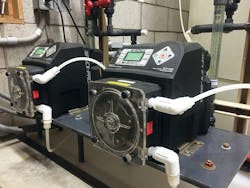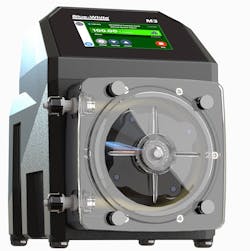Mammoth Lakes is a resort town located in the Sierra Mountain Range of North Eastern California, USA. The area is well known for both winter and summer tourist activities and as such, the town experiences a high seasonal demand on its water resources during those times when it encounters a large influx of tourists.
The towns’ drinking water resources consist of nine wells, as well as fresh water from Lake Mary, situated above the town. Mammoth Community Water District developed two Ground Water and one Surface Water treatment stations to purify the drinking water.
The Problem
Arsenic is present in the well water and it was imperative the Water District install a system which would successfully remove the arsenic and render the water safe for human consumption.
Mammoth Water District utilizes Sodium Hypochlorite (NaClO) and Ferric Chloride (FeCL₃) in a multi-step arsenic removal process. Injection of these chemicals into the raw ground water transforms the arsenic molecules into a precipitate which can then be filtered out of the water.
In addition, the water in one of the wells requires a higher concentration of the chemical in order to achieve optimum arsenic removal. Operators segregated this well during treatment which led to an overall reduction in chemical consumption and related costs. The treated water could then be re-integrated with that of the other wells.
Originally, the Well Stations utilized Solenoid Style pumps but discovered that the off-gassing nature of liquid NaClO caused these pumps to vapor lock, which interrupted the chemical feed process until they were serviced.
Additionally, when solenoid diaphragm pumps were used, the chemical tank required constant maintenance. If fluid volume levels fell below the level of the pump head, the pump became susceptible to suction lift errors, including loss of prime.
The Solution
Whereas diaphragm pumps tend to lose their prime and fail when gasses build up in the pump head, peristaltic pumps are capable of pumping both fluid and gas and don’t lose prime.
The solution was to replace the Solenoid pumps with Peristaltic Dosing Pumps. Peristaltic Pumps are extremely effective when pumping off-gassing chemical, while also maintaining smooth, accurate and constant flow rate.
The District specifically chose Blue-White Industries’ FLEXFLO® Peristaltic Pumps.
The Result
The Mammoth Lakes Water District installed the FLEXFLO® Model M3 Dosing Pumps to assist in the treatment of the town’s water and removal of the arsenic. These pumps have proven to be extremely effective, are known to provide precision accuracy and excellent reliability.
The FLEXFLO® pump head serves as a check valve, no matter what the level in the chemical tank may be, the peristaltic pump has reliable suction lift and will not lose prime.
Utilizing the pumps’ 4-20mA input, the Water District was able to set the desired dosage in the SCADA, based on the incoming flow of water to the plant. The FLEXFLO M3 is able to manage fluctuations in feed demand, keeping chemical dosing at a consistent ratio.
The FLEXFLO® M3 is equipped with Blue-White’s exclusive, built-in, Tube Failure Detection System (TFD). This technology detects a wide range of conductive chemicals with no false triggering. If the TFD detects tube failure, the pump will automatically shut off and energize a relay switch. This permits communication with external equipment, such as a back-up pump or alarm. It also serves to prevent chemical spills and added downtime.
FLEXFLO® M3 is capable of feed rates to 33.3 GPH/126 LPH and a 10,000:1 turndown ratio. The Maximum pressure rating is 125 PSI / 8.6 Bar.
The M3 peristaltic dosing pumps successfully assisted in the resolution of water treatment challenges at Mammoth Community Water District.

